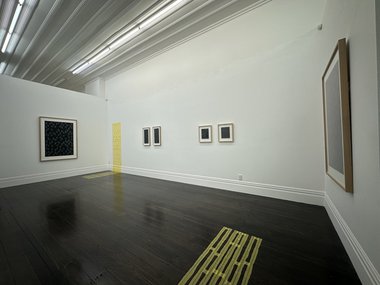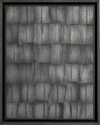John Hurrell – 4 December, 2024
Herber's framed gentle and delicate grids of torn grey tape are impossible to photograph accurately. Their tonal values are so subtle that photography tends to introduce a harshness by inaccurately widening the tonal range. They show no trace of sheen, only bursts of softly burnished graphite that occasionally turn into slightly paler flares. Her control over these normally messy and unruly materials is extraordinary.
On Rogers’ white walls we find a dozen framed and usually glassed-over grids of graphite applied to sticky foto tape, and on the walls and floor two non-immersive, graphite-free, foto tape installations. Here Veronica Herber explores firstly very soft grey torn tape accumulations arranged in dense grids, and secondly straight linear structures of yellow translucent tape applied directly to the room’s dominant vertical and horizontal planes.
Her framed gentle and delicate grids of torn grey tape are impossible to photograph accurately. Their tonal values are so subtle that photography tends to introduce a harshness by inaccurately widening the tonal range. They show no trace of sheen, only bursts of softly burnished graphite that occasionally turn into slightly paler flares. Herber’s control over these normally messy and unruly materials is extraordinary.
Within the rectangular groups of grey paper fragments the contrast between torn and straight edges is crucial in generating a subtle flicker. The impenetrable grey tone (a startling contrast to the un-graphited translucent foto tape) perhaps alludes to Jasper Johns and has a compelling meditative quality about it. Because its back side is produced sticky, the newly grey manufactured tape shows no suggestion of its glued side causing excess gummy residue to squirt out the sides.
There is something meditative about standing in front of these dominant midtone greys exploited as units positioned in a vertical grid. Horizontal and vertical scanning encourages contemplation, through its avoiding of any chromatic or value extremes within a more-or-less even opaque field.
The other works, the two yellow taped L-shaped installations that extend down the walls and across the floor, emphasise linked parallel lines (one side with a straight edge, the other cut undulating) traversed occasionally by right-angled intersections racing through, breaking the flow.
Like the panels, they come from an improvised process and are not rigidly compositionally predictable or formulaic. The stuck-down lemony tape exudes a rawness and linearity not detectable in the graphite-covered fragments, and creates an intriguing contrast, for the panels have an organic rhythmic quality reminiscent of bark or patterned moth wings, with a clearly apparent structure that allows loose variations to take over and dominate.
Rich in arboreal and entomological associations, the grey graphite works are a real treat with their fine intricacy of hand-torn edge, prodding your memories to dig out morphological tactile links and perhaps semantic nuances. The other works hint at Bochneresque avant-gardism, but text free and (like him) reliant on generic planar architectural features. The two sorts of very different project work together well.
John Hurrell












 Two Rooms presents a program of residencies and projects
Two Rooms presents a program of residencies and projects Advertising in this column
Advertising in this column



This Discussion has 0 comments.
Comment
Participate
Register to Participate.
Sign in
Sign in to an existing account.